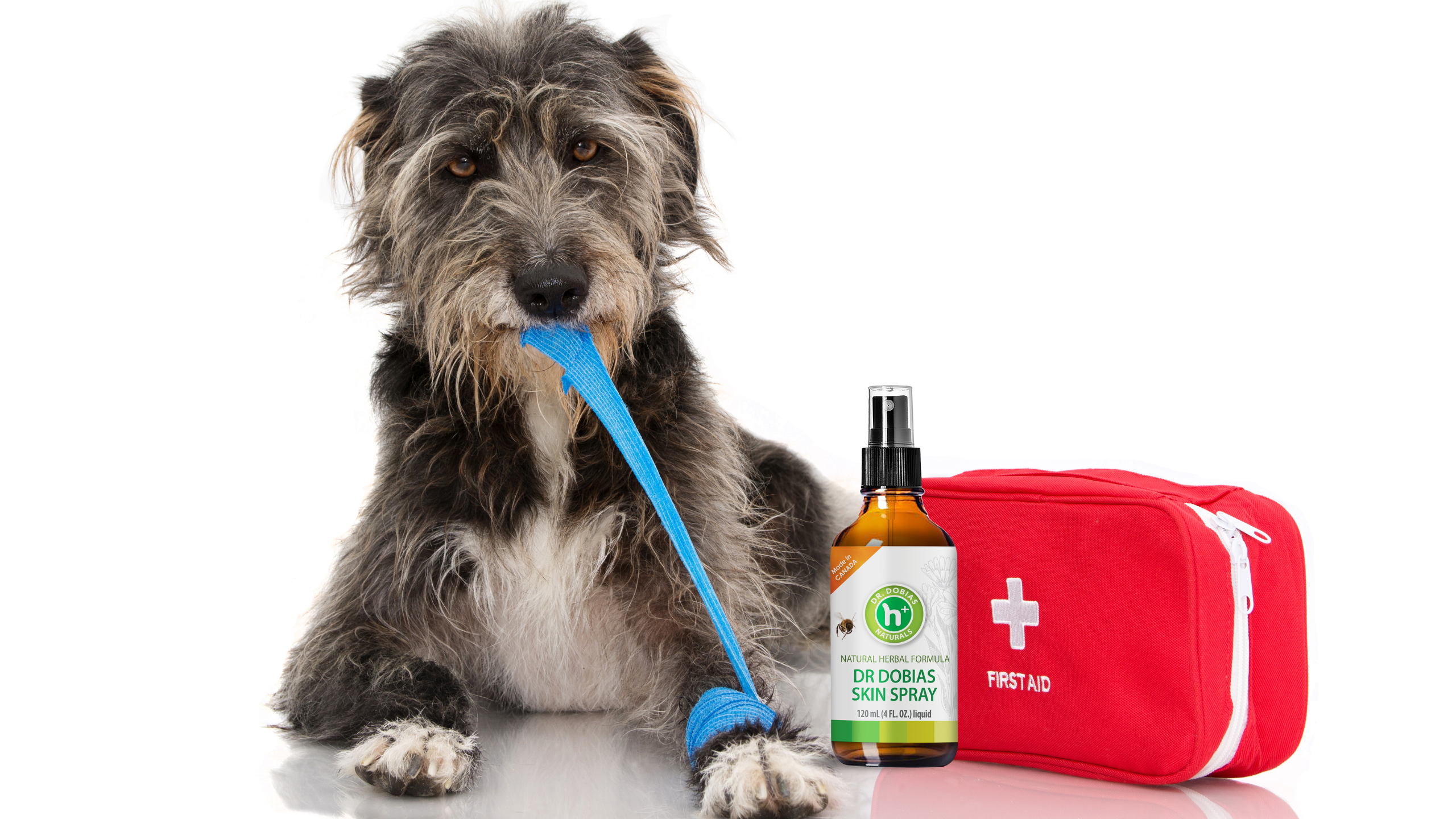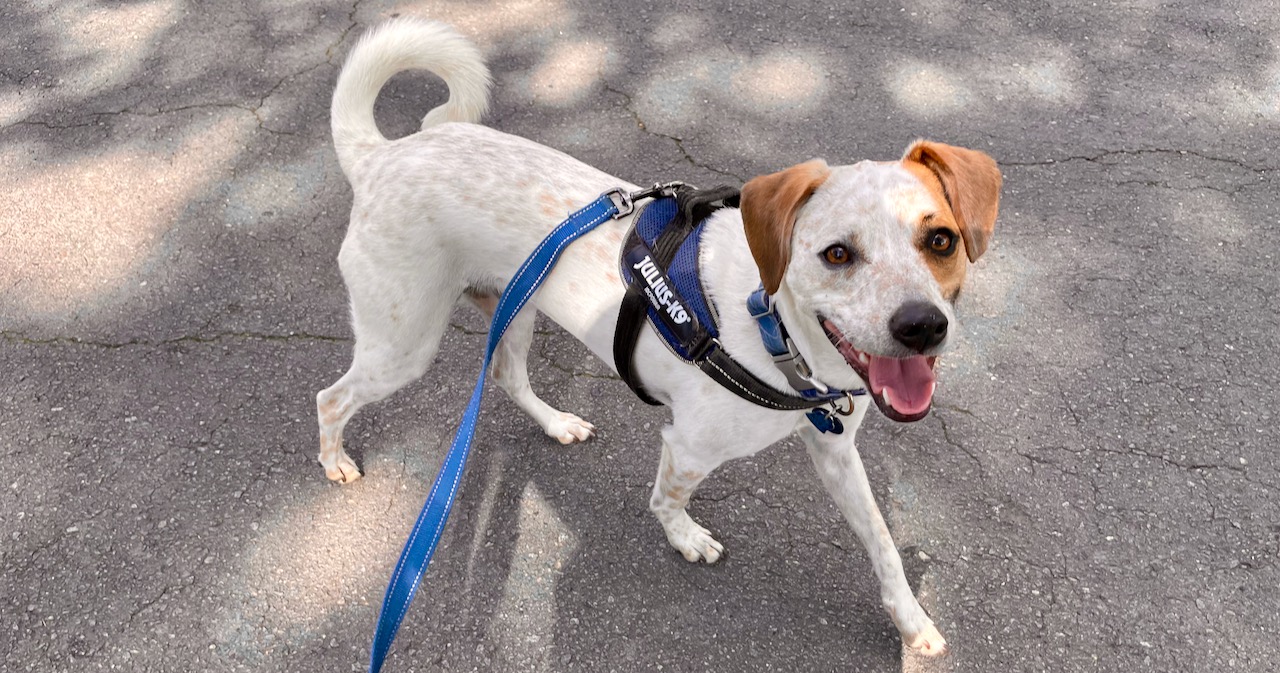Redefining the care for wounds, scrapes, stings, bites or fungus – the power of herbal healing
Do you recall the last time you or your animal friend had a scrape or a cut? Remember the stinging sensation of the antiseptic, the pain, the worry of ensuring the wound remains clean, and the struggle of managing to prevent an infection?
Most people worry about infections and struggle to make sense of conflicting wound-healing recommendations online.
What if I told you that the key to quicker, safer wound healing could be as simple as applying a herbal spray that addresses pain, swelling, and bleeding and supports faster healing?
In my early days as a vet, I worked with horses who were very good at running through barbed wire fences, which gave me extensive experience in the area of skin healing.
Working with horses made me understand the secret to faster healing was hydrotherapy – taking a hose and rinsing the wound several times a day for 5-10 minutes with cold water to keep it clean.
The stream of water not only prevents wounds from drying it also washes off bacteria and prevents infection.
When I ventured into small animal practice, I found a wide acceptance of chlorhexidine soap for wound care.
Most people assume that because it is widely used, it’s got to be good, but this isn’t necessarily true.
Chlorhexidine soap may be okay for killing bacteria, but it is also toxic to the skin cells that need to heal, which slows down the healing process; plus, it is considered an irritant to skin, eyes, lungs, and mucous membranes. It’s surprising to me that chlorhexidine is still used in mouthwash.
You might think hydrogen peroxide is a safer alternative; however, even though it turns into water when it bubbles up, the chemical reaction destroys skin cells along with bacteria.
This is why hydrogen peroxide also slows down the healing process and why I never use it.
Then there’s Polysporin, a household name for wound-healing antibiotic ointments and creams. It may surprise you to hear that I never use it. The petroleum jelly base used in these products is the same stuff we get from crude oil, and it’s a skin irritant.
Overusing these products also breeds antibiotic-resistant bacteria, creating a film that slows healing. Dogs and cats are also attracted to the greasy substance, and licking causes more harm. So, they’re not really the best solution for wounds after all.
A wound healing method that has been proven with 20+ years in practice.
I first treat almost any wound, incision, or cut with a thorough flush of body-temperature water or a saline solution. I then dry the wound and apply a herbal Skin Spray that’s pH optimized to promote quick healing.
Skin Spray supports fast wound healing, decreases wound swelling, and reduces pain and discomfort thanks to a blend of four herbs that work in synergy.
Skin Spray is based on a European tradition of three generations of healers. I was lucky enough to have learned about herbs at an early age from my grandfather, an herbalist, and from my father, a veterinarian.
Unlike traditional disinfectants and chemical or antibiotic-based wound treatments, Skin Spray contains herbs that work in synergy with the body, activating the body’s immune defenses. It is also non-toxic, which is particularly helpful for pets that enjoy licking off topical products.
Meet the 4 powerful herbs that provide fast, pain-free natural healing:
- Calendula is not just a pretty flower in the garden. It is nature’s answer to healing wounds, fighting acne, calming inflammation, and even controlling bleeding, all in addition to its antiviral and anti-carcinogenic effects.
- Hydrastis (Goldenseal) amplifies the medicinal effects of other herbs while bringing its own anti-inflammatory and anti-microbial power to the equation.
- Witch Hazel is a natural astringent that minimizes inflammation, reduces swelling, and addresses various skin problems, including wounds, acne, bruises, and insect bites.
- Yucca treats skin lesions and sprains, reduces inflammation, and stops bleeding. It is also known for soothing joint and muscle pain.
A surprising fact about wound healing and scabs
Most people still believe that having a thick scab supports healing, but this isn’t true. In fact, thick scabs lead to increased chances of infection and more prominent scarring. Gently soaking and then removing a scab allows for quicker healing.
Sounds contrary to conventional wisdom, right? But during my 25-plus years in practice, I’ve seen how keeping the wound clean, preventing thick scab formation, and applying Skin Spray leads to faster healing than leaving the scab on.
Try it the next time you have a scratch or scrape; you might be pleasantly surprised!
How to treat different types of wounds
For minor skin wounds, scrapes, abrasions, and burns, washing under running water immediately and applying Skin Spray topically three to five times daily for a few days is optimal.
For deeper wounds, surgical incisions, or more serious burns, apply Skin Spray on a piece of gauze or bandage liberally and change it once or twice daily until the skin is healed. You can use Vetrap (a self-adhesive bandage) or something similar and spray Skin spray directly onto the bandage to SATURATE it with the herbal solution and keep it moist.
You may want to repeat, “SATURATE BABY, SATURATE!” In a thick European accent to help you remember this when you treat a cut. 😉
Even challenging wounds such as cut paws in dogs can benefit from this natural approach.
A gauze saturated with Skin Spray can prevent infections, significantly speed up wound healing, and can be used for athlete’s foot, fungus, eczema, itchy skin, ringworm, bee or wasp stings, and mosquito bites.
Ultimately, chemical antiseptics that are toxic to the wound, cells, and the whole body and harmful to the environment are not the key to effective wound healing.
This is not to say that antibiotics are never needed when treating wounds; they just aren’t needed as often as we once believed.
So the next time you or your animal friend have a wound, scratch, or sting, ensure you have Skin Spray in your emergency kit. Personally, I never travel without it.
FAQs about wound healing:
Will this wound leave a scar?
Regularly applying our Skin Spray, which encourages natural healing, can minimize the risk of scarring.
How can I stop the bleeding?
Skin Spray contains yucca, a natural herb known for its bleeding-stopping capabilities.
This cut is so deep; should I go to the ER?
If you’re concerned, you should definitely seek professional medical advice. For less serious cuts, a rinse with body-temperature water or saline solution and then application of Skin Spray can help start the healing process.
I’m worried about infection. How can I clean this properly?
Washing the wound under running water and applying Skin Spray, which contains natural anti-microbial properties, can help ward off infection.
My cut is stinging and burning. Is that normal?
Initial stinging or burning can be normal, but our Skin Spray contains herbs like calendula and witch hazel, which can help soothe these sensations.
I’ve been stung by a bee, and it’s swelling up. What should I do?
Apply Skin Spray to the sting-affected area. Skin Spray is designed to help with reducing swelling and discomfort.
This insect bite is so itchy. How can I get relief?
Skin Spray works wonders on insect bites, providing soothing relief from itching and swelling.
Is this redness around the wound normal?
Redness can be a normal part of healing but is also a sign of inflammation or an infection. Skin Spray has anti-inflammatory properties to help reduce this; however, we recommend seeing your health care provider.
I’m not sure if my tetanus vaccination is up to date. Should I be concerned?
You should always check with a healthcare provider for concerns like this. Meanwhile, keeping the wound clean with water and Skin Spray can help prevent infection.
My surgical incision looks a bit red and puffy. Is that a sign of infection?
While some redness and puffiness can be normal, Skin Spray can help reduce these symptoms and speed up healing.
I’m worried about the wound getting wet. What’s the best way to keep it dry?
Actually, keeping a wound too dry can slow healing. Using Skin Spray keeps the wound environment balanced for optimal healing.
The stitches feel tight and uncomfortable. Is this a bad sign?
Tightness can be a normal part of healing. To soothe discomfort, try applying Skin Spray around the area (not directly on stitches unless advised by a healthcare professional).
The wound isn’t healing as fast as I thought it would. Is something wrong?
Every person and every wound is different. If you’re concerned, seek medical advice. And remember, regular application of Skin Spray can support faster healing.
The cut still hurts, even after a couple of days. Should it still be painful?
Some discomfort can be normal, but Skin Spray can help soothe pain and support healing. If pain persists, seek medical advice.
The wound is oozing a strange liquid. Is this part of the healing process?
Some oozing can be normal, but excessive or coloured discharge can indicate infection. Skin Spray can help prevent infection but consult with a healthcare provider if you’re concerned.
My child has a cut. How can I make them more comfortable?
Clean the wound with water or saline solution and apply Skin Spray. It’s safe, non-toxic, and can help soothe pain and discomfort.
I’ve been bitten by a mosquito, and it’s getting bigger. Is this an allergic reaction?
It could be. Skin Spray can help soothe the itchiness and swelling. For severe reactions, seek medical advice.
I don’t like the sting from disinfectants.
Skin Spray cools and soothes the wound and reduces the pain within a few minutes after application.
I’m worried about the long-term effects of using chemical treatments.
Skin Spray is a natural, non-toxic treatment option that’s safe for long-term use and doesn’t harm the body or the environment.
I have sensitive skin. Can I still use this spray?
Absolutely! The ingredients in Skin Spray are natural and gentle, making it a great option even for sensitive skin types.
My pet can’t seem to stop licking their wounds. Is this safe if ingested?
Skin Spray is safe and non-toxic, so if your pet licks the treated area, there’s no need to worry.
I’m scared my wound will leave a scar.
Skin Spray promotes healthy tissue growth, helping to minimize scarring. Remember, keeping wounds clean and preventing thick scab formation is crucial for scar prevention.
I’m unsure when to seek professional medical help for my wound.
Skin Spray can be effective for many types of wounds, but it’s always important to seek professional medical advice for deep, large, or infected wounds or if the condition doesn’t improve within a few days.
Can this spray be used on all types of wounds?
Yes, Skin Spray can be used on various wounds, from minor cuts and scrapes to more significant injuries. For severe wounds, it’s always best to seek medical attention.
What about the environmental impact of my products?
Skin Spray’s natural, environmentally friendly formulation makes it a guilt-free choice for wound care.
Should I keep the wound dry for it to heal properly?
While cleanliness is essential, keeping a wound dry can slow healing. Skin Spray maintains a moist healing environment, promoting faster recovery.
Will this spray sting my wound like other antiseptics?
No, Skin Spray provides a cooling, soothing sensation, unlike traditional antiseptics’ typical sting.
Should I leave the scab on or take it off for the wound to heal?
Gently removing the scab and keeping the wound clean, coupled with Skin Spray application, can speed up healing.
How do I apply this spray on a more serious wound or burn?
Skin Spray can be applied directly onto gauze or a bandage, which is then placed on the wound. Remember, serious wounds should always be seen by a healthcare professional.
I’m unsure if this treatment will work for my pet’s specific wound.
Skin Spray is versatile and can be beneficial for various wounds. However, if your pet has a severe or non-healing wound, it’s best to seek advice from a vet.


